

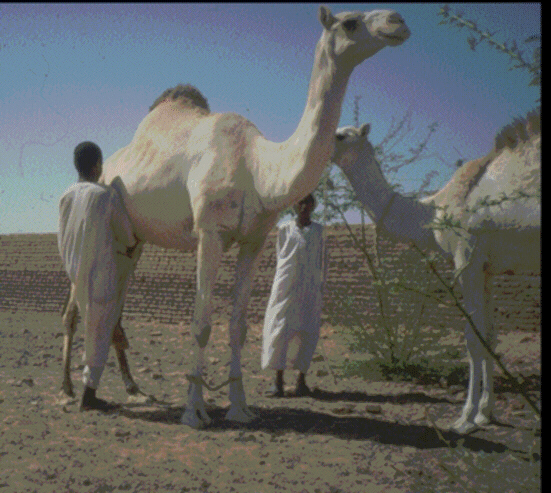 Perhaps 11,000 or 12,000 years ago humans first domesticated small ruminants as
a convenient means of meeting immediate needs for food and eventually with
additional contributions toward clothing and transport. Exploitation of animals
for dairy purposes was a much later innovation. Mammalian females usually
produce only sufficient milk for their own offspring and resist actively
whenever others attempt to obtain some. Somewhere back in antiquity farmers
found they could obtain small amounts of milk from lactating females after
natural suckling stimulated the "milk-let-down" reflex. Animal
domestication and selection progressed to the point where the sight, smell and
sound of the young animal was sufficient to initiate this reflex in a few and
later in more females. Throughout most of human history, however, dairy
products remained rare and expensive, available only during very limited
seasons of the year as a secondary output from dual-purpose animals.
Perhaps 11,000 or 12,000 years ago humans first domesticated small ruminants as
a convenient means of meeting immediate needs for food and eventually with
additional contributions toward clothing and transport. Exploitation of animals
for dairy purposes was a much later innovation. Mammalian females usually
produce only sufficient milk for their own offspring and resist actively
whenever others attempt to obtain some. Somewhere back in antiquity farmers
found they could obtain small amounts of milk from lactating females after
natural suckling stimulated the "milk-let-down" reflex. Animal
domestication and selection progressed to the point where the sight, smell and
sound of the young animal was sufficient to initiate this reflex in a few and
later in more females. Throughout most of human history, however, dairy
products remained rare and expensive, available only during very limited
seasons of the year as a secondary output from dual-purpose animals.
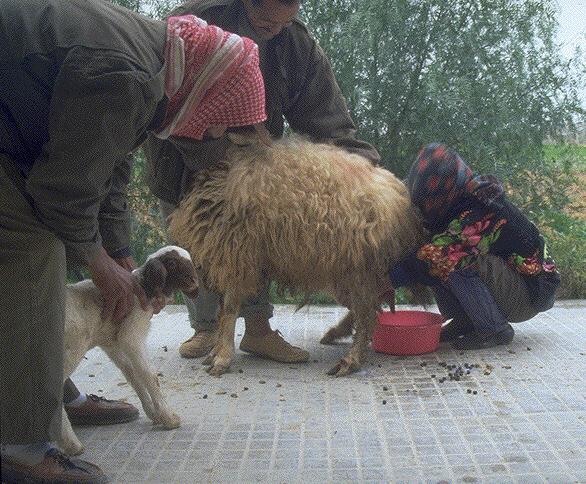 We now know that the
"milk-let-down" reflex is a conditioned response that farmers have
exploited since at least the time of the Sumarian culture (circa 3,000
BCE). Over a considerable period and through a process
of gradual adaptation and selection, more females were conditioned to let-down
milk in response to a variety of auditory sounds and tactile sensations,
eventually even in the absence of their young. Thus, we now have breeds of
cattle, buffalo, goats and sheep in which the let-down reflex requires only the
mildest environmental stimuli. This behavioral change occurred in conjunction
with selection for greater production so dairy breeds now yield much more milk
than would be necessary for nutrition of their offspring. Dairy products
eventually became a staple food in many cultures, providing opportunity for an
additional livestock commodity and the future development of specialized
production systems.
We now know that the
"milk-let-down" reflex is a conditioned response that farmers have
exploited since at least the time of the Sumarian culture (circa 3,000
BCE). Over a considerable period and through a process
of gradual adaptation and selection, more females were conditioned to let-down
milk in response to a variety of auditory sounds and tactile sensations,
eventually even in the absence of their young. Thus, we now have breeds of
cattle, buffalo, goats and sheep in which the let-down reflex requires only the
mildest environmental stimuli. This behavioral change occurred in conjunction
with selection for greater production so dairy breeds now yield much more milk
than would be necessary for nutrition of their offspring. Dairy products
eventually became a staple food in many cultures, providing opportunity for an
additional livestock commodity and the future development of specialized
production systems.
The major breeds of dairy cattle found on specialized dairy farms throughout much of the world are Ayrshire, Brown Swiss, Gurnsey, Jersey and Holstein, with the latter predominating in many regions. Background information on these and many other breeds is available from the Department of Animal Science at Oklahoma State University.
| |
|
| Cow milk | |
| Buffalo milk | |
| Goat milk | |
| Sheep milk | |
| Camel milk | |
Very small quantities from mares & yaks.
FAOSTAT Database, 1996.
A large proportion of the production depressing problems encountered in dairy herds result from management deficiencies. Many of these can be avoided through sound planning and conscientious attention to detail but this will not happen if just left to chance. The initial step in planning a new or reorganizing an existing livestock enterprise should be the establishment of a production goal that is set high enough to provide challenge, but low enough to be achievable. Whenever herds produce for commercial markets, this goal should represent the projected value of output that would be sufficient to exceed all predicted fixed and variable operating costs likely to be incurred through operation of the unit and to provide a reasonable profit. Once this is decided herd operators should consult with their veterinarians and other advisors to devise an entire series of specific objectives, covering each step in the production process, that must be attained to have reasonable expectations of meeting the output goal. These should include projected age at first calving, average productivity for females in various age groups, acceptable somatic cell counts, desirable reproductive performance and the replacement rate. Other more specific objectives might be to keep the percentage of females with clinical or subclinical mastitis, prolonged postpartum acyclicity, reproductive problems, dystocia or other clinical diseases below a reasonable number. Through this process a series of acceptable minimum standards can be described for each phase of the operation. These represent the best current estimates of where output returns will be affected so they may no longer cover input costs, indicating corrective actions are necessary.
The adoption of a positive animal identification method and a simple but comprehensive recording system are important components of the planning exercise. Current resources must be examined to determine if these are adequate or require additional supplementation to provide a reasonable expectation of reaching the output goal. Existing stock must be of sufficient quantity and quality to produce the anticipated yield or replacements must be procured. The physical facility should also be assessed to determine if this is sufficient in its present form or if modifications are needed to allow efficient production. Attention must be given to available labor, deciding whether the current staff are qualified and adequate.
Once the resources have been evaluated and judged acceptable in their existing or modified form, a specific operating system can be formulated. Attention must be paid to all aspects of animal related activities such as selection, feeding, mating, parturition and disease prevention. The nutrition program should cover both the quantity and quality of feed for animals of various ages and production stages in conjunction with regular monitoring through condition scoring. Procedures for disease prevention, sanitation and monitoring udder health, estrous detection, mating, fertility monitoring, pregnancy checking and parturition must be detailed with specific responsibilities assigned to individuals who are held accountable for performance. A series of meaningful but achievable production-related bonuses provide excellent incentives to motivate both managers and animal attendants to do their best at all times
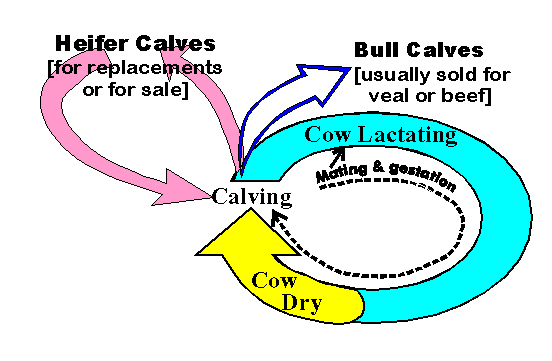
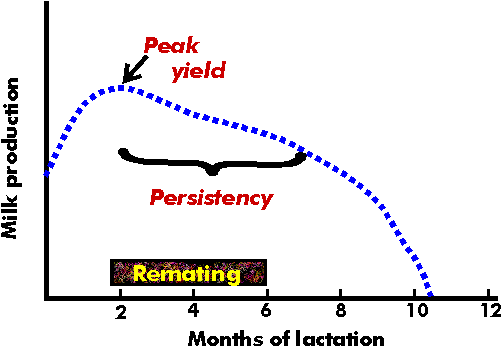 The main goal of any dairy herd is to produce milk
as conveniently and economically as possible. Since the bovine gestation period
is nine months long and cows require a postpartum recovery period of several
months before initiating another pregnancy, it is convenient to plan around a
yearly calving interval. Ideally, cows would lactate for about ten months
followed by a two month dry period, as illustrated in the accompanying figure.
They should be remated successfully during the first third of lactation,
progress through another gestation and calve again to initiate another
lactation. However, even with reasonable management, a substantial number of
animals fail to conceive as anticipated so calving intervals exceed twelve
months. Failure to achieve a twelve month calving interval is not disastrous
since almost all improved dairy cows produce reasonable quantities of milk for
longer than ten months. Thus, although daily yields are considerably below peak
amounts, they still return something over feed and maintenance costs. The
actual calving interval for most herds with reasonable standards of management
will usually range between 12.5 and 15 mo. Once the interval extends beyond
this duration, most cows in the herd spend too much time in the lower portions
of the lactation curve where the margin over feed costs is minimal or even
negative. Also, in such instances, the average milk and offspring production
per day of herd life is lower.
The main goal of any dairy herd is to produce milk
as conveniently and economically as possible. Since the bovine gestation period
is nine months long and cows require a postpartum recovery period of several
months before initiating another pregnancy, it is convenient to plan around a
yearly calving interval. Ideally, cows would lactate for about ten months
followed by a two month dry period, as illustrated in the accompanying figure.
They should be remated successfully during the first third of lactation,
progress through another gestation and calve again to initiate another
lactation. However, even with reasonable management, a substantial number of
animals fail to conceive as anticipated so calving intervals exceed twelve
months. Failure to achieve a twelve month calving interval is not disastrous
since almost all improved dairy cows produce reasonable quantities of milk for
longer than ten months. Thus, although daily yields are considerably below peak
amounts, they still return something over feed and maintenance costs. The
actual calving interval for most herds with reasonable standards of management
will usually range between 12.5 and 15 mo. Once the interval extends beyond
this duration, most cows in the herd spend too much time in the lower portions
of the lactation curve where the margin over feed costs is minimal or even
negative. Also, in such instances, the average milk and offspring production
per day of herd life is lower.
Dairy farmers seek consistently for methods to improve production efficiency
(milk per unit of feed or per hectare of land cultivated) since, with high
efficiency, the nutrients used for maintenance constitute a smaller proportion
of the total intake. This requires close attention to the composition of diet
for each production group, plus the method and frequency of feeding. Various
procedures exist which are reported to enhance milk production (see following
table). Each must be evaluated for convenience, cost effectiveness and effect
on animals and animal attendants before any are adopted.
| Production Enhancing Procedure | |
| Proper prestimulation (40 - 60") | |
| Stripping | |
| Three times milking | |
| Four times milking | |
| Extended lighting | |
| rbST | |
| Rumensin | |
Dairy producers should establish an operational plan for each phase that, if exercised properly, provides a reasonable chance of achieving the production goals. This involves:
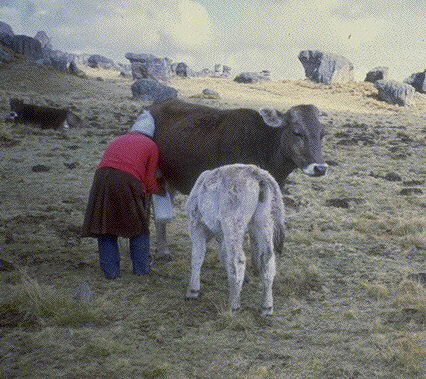 The only absolutely essential inputs necessary for dairying are a
lactating female and some sort of container to hold her milk. In practice,
however, the requirements are almost always substantially more elaborate.
The only absolutely essential inputs necessary for dairying are a
lactating female and some sort of container to hold her milk. In practice,
however, the requirements are almost always substantially more elaborate.
Some climates allow almost totally pasture based dairying with little or no need for shelter. In semi-arid, tropical regions it is only necessary to provide protection from severe solar radiation or, occasionally, from flooding during rainy seasons. In contrast, most of Canada, like many other temperate climate regions, experiences severe winter cold. Thus, dairy cattle may be allowed to graze on pasture during late spring, summer and part of the fall, but are then confined during the colder months. Although this mixture of grazing and confinement is still common, some herds are confined totally throughout the entire year.
Because natural conditions seldom maintain cattle within their comfort zones throughout all seasons of the year., shelters are usually necessary to protect animals from inclement weather. Appropriate confinement facilities protect both the animals and animal attendants from temperature extremes and potentially hazardous conditions. To accomplish this all animal holding units should provide for supervision and ease of handling during at all times, including feeding, milking, breeding, parturition and health protection activities. In addition, any confinement facility must be constructed and operated to meet the legal requirements for preservation of product quality and to ensure that animals are always treated humanely.
The current economic conditions in many regions compel livestock producers to reduce production expenses wherever possible. Since conventional dairy barns represent substantial fixed cost for there initial construction, for carrying charges and for depreciation, dairy operators who intend to replace existing or add additional facilities seek for less expensive alternatives. In temperate climate regions most new constructions are now modified pole, arched steel or fabric covered enclosures rather than the traditional barn with extensive feed storage and handling space built above a heavily reinforced livestock stable. Confinement housing can be in tie stall barns where neck chains or collars restrain each cow in her own space for most or all of the day and night. Alternately, cows might be housed in free stall barns or loose housing units where animals can move about in the passage or exercise areas and enter into comfort stalls or resting areas whenever they choose.
| Advantages | Disadvantages |
| cleaner cows | tying and untying difficulties |
| individual attention for all animals | reduced opportunity for exercise |
| readily mechanized | labor intensive if not mechanized |
| comfortable for most chores | stooping to milk |
| economical and practical, particularly for smaller herds | less opportunity for choice, more criticism from animal welfare groups |
| Advantages | Disadvantages |
| economical operating costs | expensive construction costs |
| readily mechanized | less individual attention |
| animals exercised regularly | more competition |
| some flexibility in organizing different management-feeding groups | dirtier cows if improperly designed or operated |
Most livestock constraint facilities are built for the convenience of human operators rather than for the benefit of animals under their care. Free-stall housing for dairy cattle can be an exception, allowing the animal occupants choice to move freely between resting, feeding and watering areas. Particular consideration must be given to the milking area; footing; manger and watering space; stall construction, size and bedding material; manure handling and facilities for moving animals. Attention to proper design, construction and daily operation should provide a minimal stress environment for healthy, clean and productive cows. Check out the Dairy Management Factsheet from the University of Alberta for additional ideas on free-stall design and bedding.
Additional housing, either combined with or separated from the primary facility for keeping the milking cows, is necessary for females at calving time, for young calves (either indoor or outdoor), for growing heifers and for dry cows. Again these units must be suited to the climatic conditions prevalent in the region so they protect animals from extremes of both heat and cold.
Special precautions must be afforded to very young calves since they do not yet have functional rumens so do not generate the large amounts of body hear from fermentation that are typical of older ruminants. Thus, some form of specialized housing is necessary to protect them from severe cold or drafts. Various indoor and outdoor systems are available.
Regardless of the age or production stage, the principal objective of all housing should be the comfort or well-being of the animals. Comfort affects directly the feed intake, fertility, longevity, health and production of each animal. Farmers who neglect animals or fail to provide housing conditions that satisfy sound animal welfare considerations cannot operate effectively and should find some other employment.
Click here to obtain more information on feeding, health and reproduction in dairy herds.